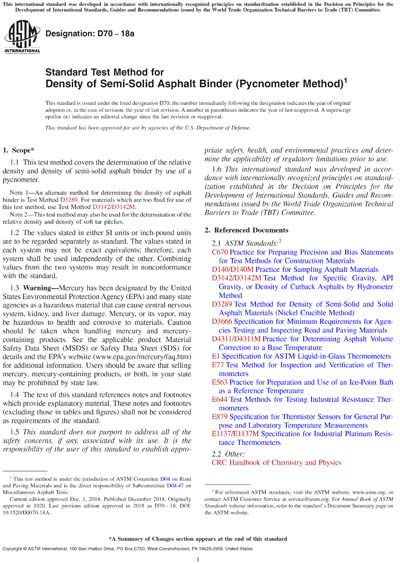Historical
ASTM D70-18a
Standard Test Method for Density of Semi-Solid Asphalt Binder (Pycnometer Method)
1.1 This test method covers the determination of the relative density and density of semi-solid asphalt binder by use of a pycnometer.
Note 1: An alternate method for determining the density of asphalt binder is Test Method D3289. For materials which are too fluid for use of this test method, use Test Method D3142/D3142M.
Note 2: This test method may also be used for the determination of the relative density and density of soft tar pitches.
1.2 The values stated in either SI units or inch-pound units are to be regarded separately as standard. The values stated in each system may not be exact equivalents; therefore, each system shall be used independently of the other. Combining values from the two systems may result in nonconformance with the standard.
1.3 Warning—Mercury has been designated by the United States Environmental Protection Agency (EPA) and many state agencies as a hazardous material that can cause central nervous system, kidney, and liver damage. Mercury, or its vapor, may be hazardous to health and corrosive to materials. Caution should be taken when handling mercury and mercury-containing products. See the applicable product Material Safety Data Sheet (MSDS) or Safety Data Sheet (SDS) for details and the EPA’s website (www.epa.gov/mercury/faq.htm) for additional information. Users should be aware that selling mercury, mercury-containing products, or both, in your state may be prohibited by state law.
1.4 The text of this standard references notes and footnotes which provide explanatory material. These notes and footnotes (excluding those in tables and figures) shall not be considered as requirements of the standard.
1.5 This standard does not purport to address all of the safety concerns, if any, associated with its use. It is the responsibility of the user of this standard to establish appropriate safety, health, and environmental practices and determine the applicability of regulatory limitations prior to use.
1.6 This international standard was developed in accordance with internationally recognized principles on standardization established in the Decision on Principles for the Development of International Standards, Guides and Recommendations issued by the World Trade Organization Technical Barriers to Trade (TBT) Committee.
Content Provider
ASTM International [astm]






